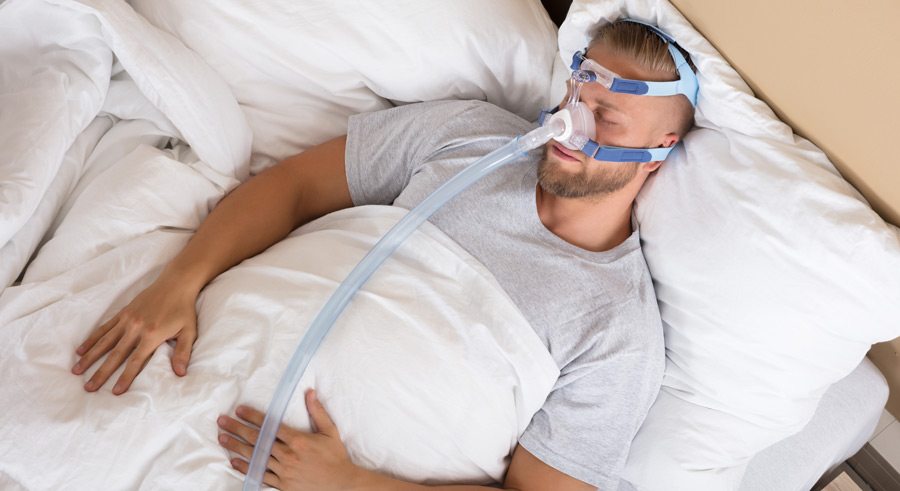At Cedar Valley ASCENT, a leader in the Cedar Valley in the treatment of sleep apnea, we understand the serious health risks posed by sleep apnea and that’s why we offer a comprehensive line of sleep apnea treatments designed to correct this condition and get you back to sleeping safely. Sleep apnea treatment specialist Dr. David J. Congdon is a Mayo Clinic-trained and double board-certified otolaryngologist who understands how your nighttime breathing affects your entire health and who is committed to working with each of his patients to develop a personalized sleep apnea treatment plan. These treatment options depend on the severity of the patient’s condition and are tailored to his or her specific lifestyle and circumstances. Sleep apnea is a life-threatening condition, but you don’t have to live with it—read below to learn more or call us or click on the sidebar today to schedule your sleep apnea consultation.
Effective, Life-Changing Sleep Apnea Treatments
Lifestyle Modifications
For some patients with lower levels of sleep apnea, relatively simple treatment options exist that involve minor changes to your everyday lifestyle. These include:
- Weight
- For some patients, carrying excess weight is a primary cause of sleep apnea; in most adults, the condition is most frequently caused by being overweight or obese, as this promotes soft tissue development in the mouth and throat area that prevents airflow during sleep. Weight loss can cause the condition to diminish partially or completely, making regular exercise and appropriate diet important treatment steps.
- Nasal Sprays
- Nasal congestion that contributes to sleep apnea can be addressed through a saline-based nasal spray that clears your nasal cavities during sleep. Sprays and other similar solutions, such as decongestants, are generally short-term solutions.

- Smoking Cessation
- In addition to worsening your overall health, smoking can worsen the airway obstruction that causes sleep apnea. If you have this condition, smoking cessation will be recommended as a first step in treatment.
Ventilation Machines
More moderate cases of sleep apnea often require additional interventions beyond simple lifestyle changes. The two primary such treatments are different forms of ventilation devices, which promote opened airways during sleep.
- Continuous positive airway pressure (CPAP) machines
- This ventilator provides a consistent stream of pressure via a mask that you wear over your nose during sleep. The air pressure pushes your air passages open to prevent the tissue obstruction that results for sleep apnea sufferers. This device also inhibits snoring, and is the most common sleep apnea treatment method. Because each person is different, it may take some time to find a CPAP machine that you are comfortable with or additional modifications to the machine’s pressure levels or other settings may be needed. However, CPAP machines can provide life-changing benefits that can diminish the threats posed by sleep apnea.

- Bilevel positive airway pressure (BiPAP) machines
- Another sleep apnea treatment device is the bilevel positive airway pressure machine, which delivers automatic and adjustable air pressure during sleep. Unlike the CPAP machine, the BiPAP ventilator pushes more air through when you are inhaling, while reducing the airflow at times of exhaling, creating a more regulated level of nighttime breathing. This can benefit patients who did not respond fully to CPAP treatment or who have preexisting lung or heart conditions.
Corrective Surgery
In the most severe cases of sleep apnea, surgery is performed to correct the breathing obstruction causing the condition. This usually occurs after several other treatment options have been tried and found to be insufficient to address the problem. Sleep apnea surgery is designed to create more space in your nasal or throat airway in order to facilitate unobstructed breathing and eliminate snoring. Several different types of surgery exist, including:
- Tissue Removal
- The goal of this procedure is to correct throat vibration that leads to snoring and sleep apnea. It is accomplished by removal of rear-mouth and throat tissue as well as tonsils and adenoids.
- Jaw Repositioning
- This surgery creates additional space near the tongue and soft palate areas in the mouth by adjusting the jaw. By moving the jaw forward, patients are able to breathe more easily.
- Tracheostomy
- For patients with sleep apnea that is threatening their lives, a surgeon will create a neck opening and insert an artificial breathing tube. This surgical opening is uncovered when you sleep so that air may move past the obstructed area.
